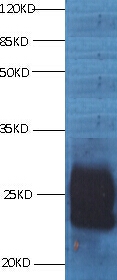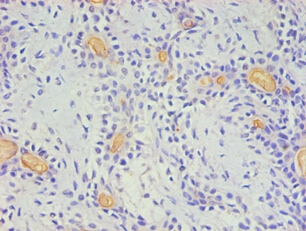Product Detail
Product NameCD59 Monoclonal Antibody
Host SpeciesMouse
ClonalityMonoclonal
Purificationprotein G purifed
ApplicationsWB IHC
Species ReactivityHu
Specificityspecific for Recombinant CD59 Protein denatured and native forms
Immunogen Typeprotein
Immunogen DescRecombinant CD59 Protein
Target NameCD59
ConjugateUnconjugated
Other NamesCD59 glycoprotein, HRF-20, MAC-IP, MACIF, MIRL, CD59
Accession NoSwiss-Prot#: P13987
Uniprot
P13987
Gene ID
966;
Calculated MW15kd
Concentration1.0mg/mL
FormulationPreservative: 0.03% Proclin 300 Constituents: 50% Glycerol, 0.01M PBS, PH 7.4
StorageStore at -20˚C
Application Details
Western blotting: 1:500 - 1:1000
Immunohistochemistry: 1:20 - 1:200
All lanes : Mouse Anti-CD59 monoclonal antibody at 1ug/ml
Line1:K562
Predicted band size : 15kd
Observed band size : 22kd
Immunohistochemical analysis of paraffin-embedded Human breast cancer using #42018 at dilution of 1:200.
Immunohistochemical analysis of paraffin-embedded human placenta tissue using #42018 at dilution of 1:200.
CD59, also named as MIC11, MIN1, MIN2, MIN3, MSK21, MIRL, MACIF, HRF20 and 1F5 antigen, is a cell surface molecule glycoprotein with MW 18-25kd. It acts as a determinant of proximal¨Cdistal cell identity. CD59 acts by binding to the C8 and/or C9 complements of the assembling membrane attack complex (MAC), thereby preventing incorporation of the multiple copies of C9 required for complete formation of the osmolytic pore. It is involved in signal transduction for T-cell activation complexed to a protein tyrosine kinase.
If you have published an article using product 42018, please notify us so that we can cite your literature.





 The lead time is currently 1 week.
The lead time is currently 1 week.



